Protein-RNA and protein-protein recognition by dual KH1/2 domains of the neuronal splicing factor Nova-1
- PMID: 21742260
- PMCID: PMC3134789
- DOI: 10.1016/j.str.2011.05.002
Protein-RNA and protein-protein recognition by dual KH1/2 domains of the neuronal splicing factor Nova-1
Abstract
Nova onconeural antigens are neuron-specific RNA-binding proteins implicated in paraneoplastic opsoclonus-myoclonus-ataxia (POMA) syndrome. Nova harbors three K-homology (KH) motifs implicated in alternate splicing regulation of genes involved in inhibitory synaptic transmission. We report the crystal structure of the first two KH domains (KH1/2) of Nova-1 bound to an in vitro selected RNA hairpin, containing a UCAG-UCAC high-affinity binding site. Sequence-specific intermolecular contacts in the complex involve KH1 and the second UCAC repeat, with the RNA scaffold buttressed by interactions between repeats. Whereas the canonical RNA-binding surface of KH2 in the above complex engages in protein-protein interactions in the crystalline state, the individual KH2 domain can sequence-specifically target the UCAC RNA element in solution. The observed antiparallel alignment of KH1 and KH2 domains in the crystal structure of the complex generates a scaffold that could facilitate target pre-mRNA looping on Nova binding, thereby potentially explaining Nova's functional role in splicing regulation.
Copyright © 2011 Elsevier Ltd. All rights reserved.
Figures
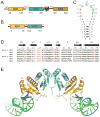
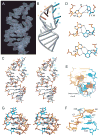

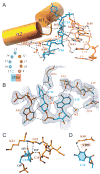
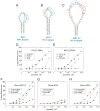
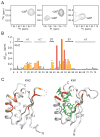
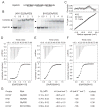
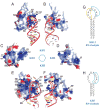
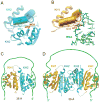
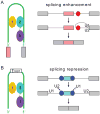
Similar articles
-
Determination and augmentation of RNA sequence specificity of the Nova K-homology domains.Nucleic Acids Res. 2004 Sep 14;32(16):4852-61. doi: 10.1093/nar/gkh799. Print 2004. Nucleic Acids Res. 2004. PMID: 15367696 Free PMC article.
-
Crystal structures of Nova-1 and Nova-2 K-homology RNA-binding domains.Structure. 1999 Feb 15;7(2):191-203. doi: 10.1016/S0969-2126(99)80025-2. Structure. 1999. PMID: 10368286
-
The onconeural antigen Nova-1 is a neuron-specific RNA-binding protein, the activity of which is inhibited by paraneoplastic antibodies.J Neurosci. 1996 Feb 1;16(3):1114-22. doi: 10.1523/JNEUROSCI.16-03-01114.1996. J Neurosci. 1996. PMID: 8558240 Free PMC article.
-
The neuronal splicing factor Nova controls alternative splicing in N-type and P-type CaV2 calcium channels.Channels (Austin). 2010 Nov-Dec;4(6):483-9. doi: 10.4161/chan.4.6.12868. Epub 2010 Nov 1. Channels (Austin). 2010. PMID: 21150296 Free PMC article. Review.
-
Developing global insight into RNA regulation.Cold Spring Harb Symp Quant Biol. 2006;71:321-7. doi: 10.1101/sqb.2006.71.002. Cold Spring Harb Symp Quant Biol. 2006. PMID: 17381312 Review.
Cited by
-
Assessing PDB macromolecular crystal structure confidence at the individual amino acid residue level.Structure. 2022 Oct 6;30(10):1385-1394.e3. doi: 10.1016/j.str.2022.08.004. Epub 2022 Aug 31. Structure. 2022. PMID: 36049478 Free PMC article.
-
mRNA Engineering for the Efficient Chaperone-Mediated Co-Translational Folding of Recombinant Proteins in Escherichia coli.Int J Mol Sci. 2019 Jun 28;20(13):3163. doi: 10.3390/ijms20133163. Int J Mol Sci. 2019. PMID: 31261687 Free PMC article.
-
MINA-1 and WAGO-4 are part of regulatory network coordinating germ cell death and RNAi in C. elegans.Cell Death Differ. 2019 Oct;26(10):2157-2178. doi: 10.1038/s41418-019-0291-z. Epub 2019 Feb 6. Cell Death Differ. 2019. PMID: 30728462 Free PMC article.
-
Short RNA molecules with high binding affinity to the KH motif of A-kinase anchoring protein 1 (AKAP1): implications for the regulation of steroidogenesis.Mol Endocrinol. 2012 Dec;26(12):2104-17. doi: 10.1210/me.2012-1123. Epub 2012 Oct 17. Mol Endocrinol. 2012. PMID: 23077346 Free PMC article.
-
LncRNA NEAT1 ameliorate ischemic stroke via promoting Mfn2 expression through binding to Nova and activates Sirt3.Metab Brain Dis. 2022 Mar;37(3):653-664. doi: 10.1007/s11011-021-00895-1. Epub 2022 Jan 24. Metab Brain Dis. 2022. PMID: 35067795
References
-
- Albert ML, Darnell RB. Paraneoplastic neurological degenerations: keys to tumour immunity. Nat Rev Cancer. 2004;4:36–44. - PubMed
-
- Beuth B, Garcia-Mayoral MF, Taylor IA, Ramos A. Scaffold-independent analysis of RNA-protein interactions: the Nova-1 KH3-RNA complex. J Am Chem Soc. 2007;129:10205–10210. - PubMed
-
- Burd CG, Dreyfuss G. Conserved structures and diversity of functions of RNA-binding proteins. Science. 1994;265:615–621. - PubMed
Publication types
MeSH terms
Substances
Associated data
- Actions
- Actions
Grants and funding
- NS40955/NS/NINDS NIH HHS/United States
- GM07739/GM/NIGMS NIH HHS/United States
- HD40647/HD/NICHD NIH HHS/United States
- R01 NS034389/NS/NINDS NIH HHS/United States
- CA49982/CA/NCI NIH HHS/United States
- HHMI/Howard Hughes Medical Institute/United States
- R56 NS034389/NS/NINDS NIH HHS/United States
- NS34389/NS/NINDS NIH HHS/United States
- T32 GM007739/GM/NIGMS NIH HHS/United States
- R01 CA049982/CA/NCI NIH HHS/United States
- R01 NS040955/NS/NINDS NIH HHS/United States
- R01 HD040647/HD/NICHD NIH HHS/United States
LinkOut - more resources
Full Text Sources

